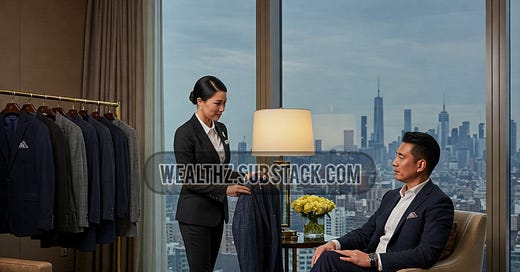The 0.1% Group: The Silent Architects of Elite Style
Understanding the Unmet Need
In the world of wealth, there are two kinds of luxury consumers: those who buy luxury and those who own it before the world even knows it exists. The founders of The 0.1% Group saw this distinction not just as a market gap—but as an empire waiting to be built.
They understood a fundamental truth: for the ultra-wealthy, time and exclusivity are the ultimate currencies. Shopping—even at the most elite boutiques—was not just inconvenient but ordinary. A CEO doesn’t have hours to browse collections. A billionaire doesn’t wait for a waitlist. A royal doesn’t wear what anyone else can buy.
Luxury personal styling existed, but it was fragmented—individual stylists, concierge services, VIP retail experiences. What was missing was a fully integrated, hyper-personalized, globally connected styling powerhouse—a firm that didn’t just dress the elite but anticipated their needs before they even had them.
Thus, The 0.1% Group was born—not just as a styling service but as an elite fashion intelligence and sourcing network.
Positioning Themselves as the Gatekeepers
Success in the ultra-luxury space is not about aggressive marketing. The true elite don’t respond to ads; they respond to whispers, exclusivity, and reputation.
From the beginning, The 0.1% Group adopted a deliberate invisibility strategy—no flashy branding, no overexposure. Their client acquisition was built on word-of-mouth alone, with one ironclad rule: if you have to ask, you can’t afford us.
They established themselves as the ultimate gatekeepers to fashion’s most untouchable pieces, leveraging relationships with:
Private ateliers and luxury houses to secure bespoke, one-of-one creations.
Auction houses and collectors to acquire ultra-rare vintage and archival fashion.
Global fashion insiders who provided access to VIP-only releases and unseen collections.
By securing items that money alone couldn’t buy, they ensured that their service wasn’t just a luxury—it was a necessity for the elite.
Scaling Without Losing Exclusivity
Scaling in the luxury sector is a paradox: grow too much, and you lose your elite status; stay too niche, and you risk stagnation.
The 0.1% Group solved this by scaling in influence, not in accessibility. They remained a tight, invitation-only network but expanded their capabilities by:
Integrating AI-driven fashion forecasting to predict styling needs before clients even made a request.
Building a global team of luxury scouts stationed in fashion capitals, ensuring first access to rare pieces.
Establishing a tiered membership system, where the highest-paying clients received pre-market access to unreleased collections.
By remaining small in clientele but vast in access, they positioned themselves as not just stylists, but silent architects of elite fashion.
The Psychology of Power Dressing
Beyond sourcing exclusivity, The 0.1% Group tapped into something deeper: the psychology of status. Their clients weren’t just buying luxury; they were buying:
Social dominance – Always appearing ahead of trends, untouchable in style.
Effortless power – Clothing that conveyed authority without a word spoken.
Security in identity – A personal brand sculpted through wardrobe precision.
Their stylists weren’t just picking clothes—they were crafting personas. A billionaire tech founder needed a wardrobe that balanced understated wealth with undeniable authority. A Middle Eastern royal required tradition-infused modernity. Every client had a narrative, and The 0.1% Group ensured their clothing told it perfectly.
The Business of Power & Perception
The 0.1% Group thrives because they understand that luxury is not about price—it’s about power, exclusivity, and perception. Their strategic journey is not just about fashion but about owning the intersection of wealth, influence, and effortless perfection. And The 0.1% Group ensures it stays that way.
Join us: ➡️ Instagram | Telegram | X ⬅️



